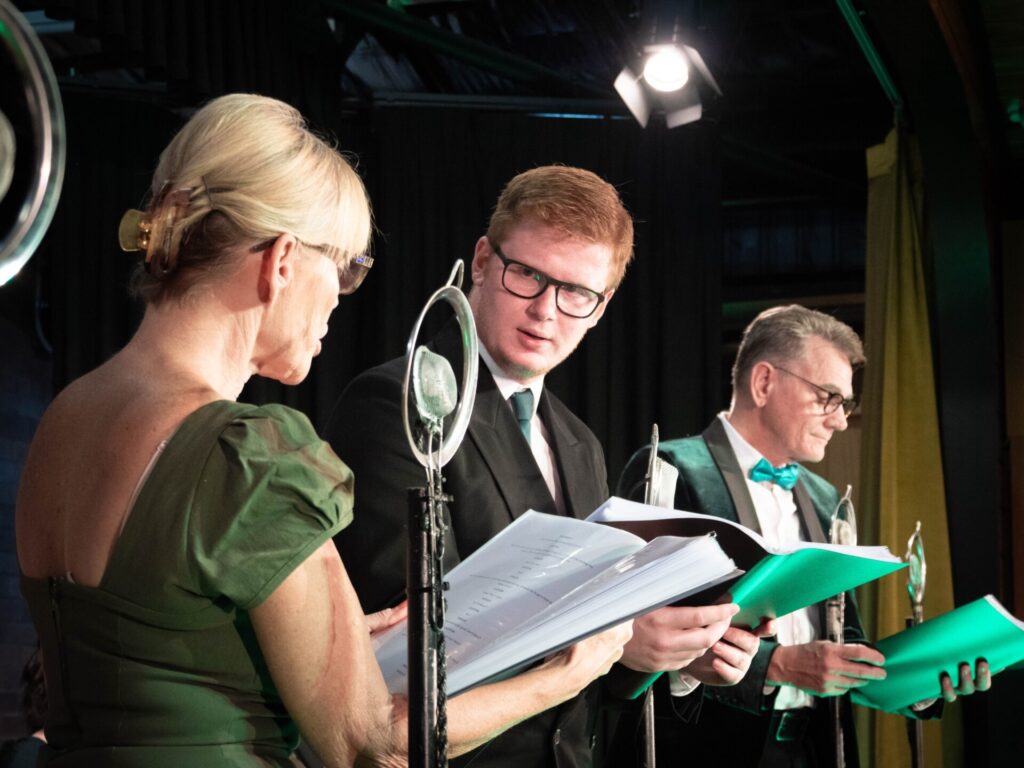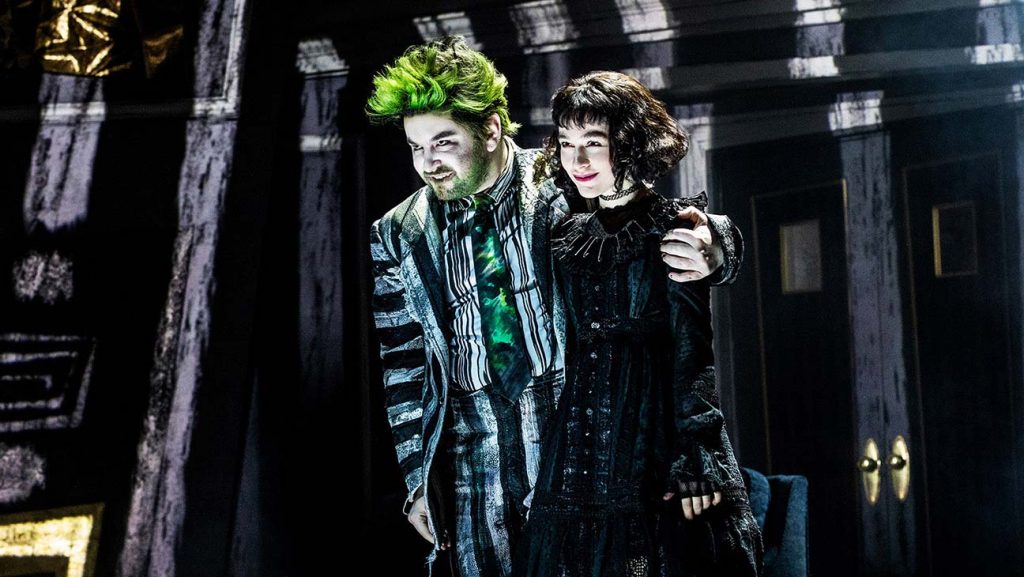
‘War of the Worlds: The LUX Radio Play’ // Nash Theatre
‘War of the Worlds: The LUX Radio Play’ was befuddling.
The air around Merthyr Road Uniting Church crackled with tension, not from the approaching thunderstorm but from the chilling evening of science fiction that New Farm Nash Theatre was about to unfold.
Originally advertised as ‘War of the Worlds: The LUX Radio Play’, Nash Theatre had neglected to explain that the performance was two shows in one evening, aptly named ‘An Evening of Science Fiction’. The central premise of this production was that the audience was watching a live LUX Radio Theatre production in 1955. However, this was not apparent unless you purchased and read the programme. From the start, with three different titles/concepts for the show, it was confusing to understand exactly what Nash Theatre was trying to present.
The show was broadcast from the LUX Radio Studio in Hollywood. Although the radio host announced that it was Hollywood, they also disclosed the name of the actual theatre location (The Brunswick Room in Brisbane). The prologue featured the Radio host/announcer introducing the first show and a message from the LUX Radio sponsors.
The first show was ‘The Day the Earth Stepped Sideways’, which was not featured in the actual LUX Radio Theatre production; this is an original work by emerging Australian writer Jay Edwards. This work centred around Helen and Bobby Nesbitt. Bobby was an aspiring scientist who had created a device to “step sideways” into parallel universes, which only worked after his mother, Helen, unknowingly activated it. The story follows Helen’s pursuit of her son Bobby as he continues to step from universe to universe.
‘War of the Worlds’ was the main attraction of the night. This version of the classic was based on George Pal’s 1952 Paramount Pictures Film rather than the original novel. The LUX Theatre show originally aired in 1955, starring Pat Crowley and Dana Andrews, followed the story of Clayton and Sylvia trying to survive the Martian invaders from Mars. After ‘War of the Worlds’ had concluded, the announcers of the LUX Radio Theatre show thanked their sponsors once more and went off the air.
The Brunswick Room in the Merthyr Road Uniting Church featured a small, simple stage. The space offered few technical effects; Lighting designer Phil Carney used plain-wash lighting to illuminate the stage and blackouts only between the acts. This production integrated the Foley techniques, which use objects to create sounds, which are more commonly used in film.
Sound designers/engineers were Hazel Newman, Rob Crook, Mark Corben, John Mann, and Jason Nash. Hazel Newman, Rob Crook, and Mark Corben were the Foley artists for this production. Seeing live Foley work on the stage behind the performers was engaging and exciting, but the team needed better communication. Newman appeared to be carrying the team and correcting them. At times, Crook and Corben missed their cues or started too early. It was great when they were all on the same page. This production also used sound effects, ambient noise, and music throughout the performance; this outshone the Foley team and made them a little redundant. Foley is not commonly seen in the theatre, and the creative team could have opted to use other sound elements.
The set was simple and featured all the items to be used by the Foley artists at the back of the stage. The front of the stage featured five evenly spaced vintage microphones. Just behind these were ten chairs that the cast used throughout the performance. Alongside this was a sign that displayed “LUX Radio Theatre” and two light boxes, one that stated “On Air” that had a green light and the other “Applause”, which lit up white as needed.
The cast generally did not use props, but each had a folder with the show’s script. Although in good faith, the large folders did hide and close off the performers at times. John Mann was the only performer in the cast who did use props, and it could have been made clearer as to the purpose. He used a compass, a sheriff’s badge, and a bible; but these were mostly unnecessary. As a radio play, not a traditional stage show, the visual aid props were superfluous.
The costumes for the cast were simple but effective. Everyone wore formal attire with a vintage feel, and each costume incorporated green.
Jason Nash directed this complicated performance. It is clear that Nash was very excited to create this production but may not have been able to narrow down the components to make it a cohesive piece. However, using Nash Theatre as a platform to introduce new work to the audience was a great idea.
Nash often broke the suspension of disbelief throughout the show, but not always in the most well-orchestrated way. As a radio show, the audience understood that the cast would stand up and approach one of the microphones when it was their turn to speak, but one would expect little to no other action on the stage besides the Foley artists. Due to the nature of the show and the lack of other technical elements, every little movement and distraction was amplified and drew focus. Something as small as an actor flipping through the pages of their folder to find their spot or the Foley cast filling up a glass of water for the cast was incredibly distracting throughout the performance.
Often, Nash directed the actors to move and act in ways that didn’t quite make sense. Simple things like moving along to the next microphone worked effectively, but was sometimes lost to the other performers active in the background. Furthermore, the cast were reacting to the story while seated; and the audience might assumed they would be “themselves” while there. Instead, they continued their performance as characters, and this somewhat distracted the audience from the standing actors.
For some parts of the show, Nash made an intelligent directorial choices such as having all the cast ad-libbing conversations during scenes where background chatter was necessary to aid the Foley Artist. This choice worked well when actors sat still and allowed the person at the microphone to lead, rather than pulling focus. For one part of the show, Nash chose for Sylvia and Clayton to physically make their way through a crowd on stage, which wasn’t necessary and didn’t add much to the show. Nash could have placed more emphasis on the performance of each cast member during their time at the microphones, rather than the various distractions.
The radio cast consisted of ten members: Alec Adsett, Sandy Adsett, John Mann, David Hill, Petra Donnison, Lara Latham, Ella Bromback, Mat McNeice, Bruce Edgerton, and Alex Thompson. They all had moments, but Sandy Adsett and Petra Donnison stood out.
Sandy played Helen Nesbitt in “The Day the Earth Stepped Sideways” and multiple supporting characters in “War of the Worlds’; Donnison played Roberta/Mrs. Carpenter in “The Day the Earth Stepped Sideways” and some supporting characters in “War of the Worlds’. Both performers had found the perfect balance in the vocal acting and physicality required for a radio show.
At times, some cast members sat reading along with their script throughout the show. Their focus could have been more curated and supportive of their fellow cast members. Select cast members could also been more well-versed in their script which was reflected in some stuttered performances throughout the show.
The “Evening of Science Fiction” presented by Nash Theatre consisted of many great puzzle pieces that didn’t always fit together. Having Foley integrated into this show was an incredible attempt and it could’ve lifted the entire performance if it had been the only creation of sound. Although with good intentions and ideas, Director Jason Nash could’ve presented a more clear and cohesive show if he had focused on one path and committed to it.
‘War of the Worlds: The LUX Radio Play’ continues at Nash Theatre until March 23rd. Tickets can be purchased on the Nash Theatre website.






